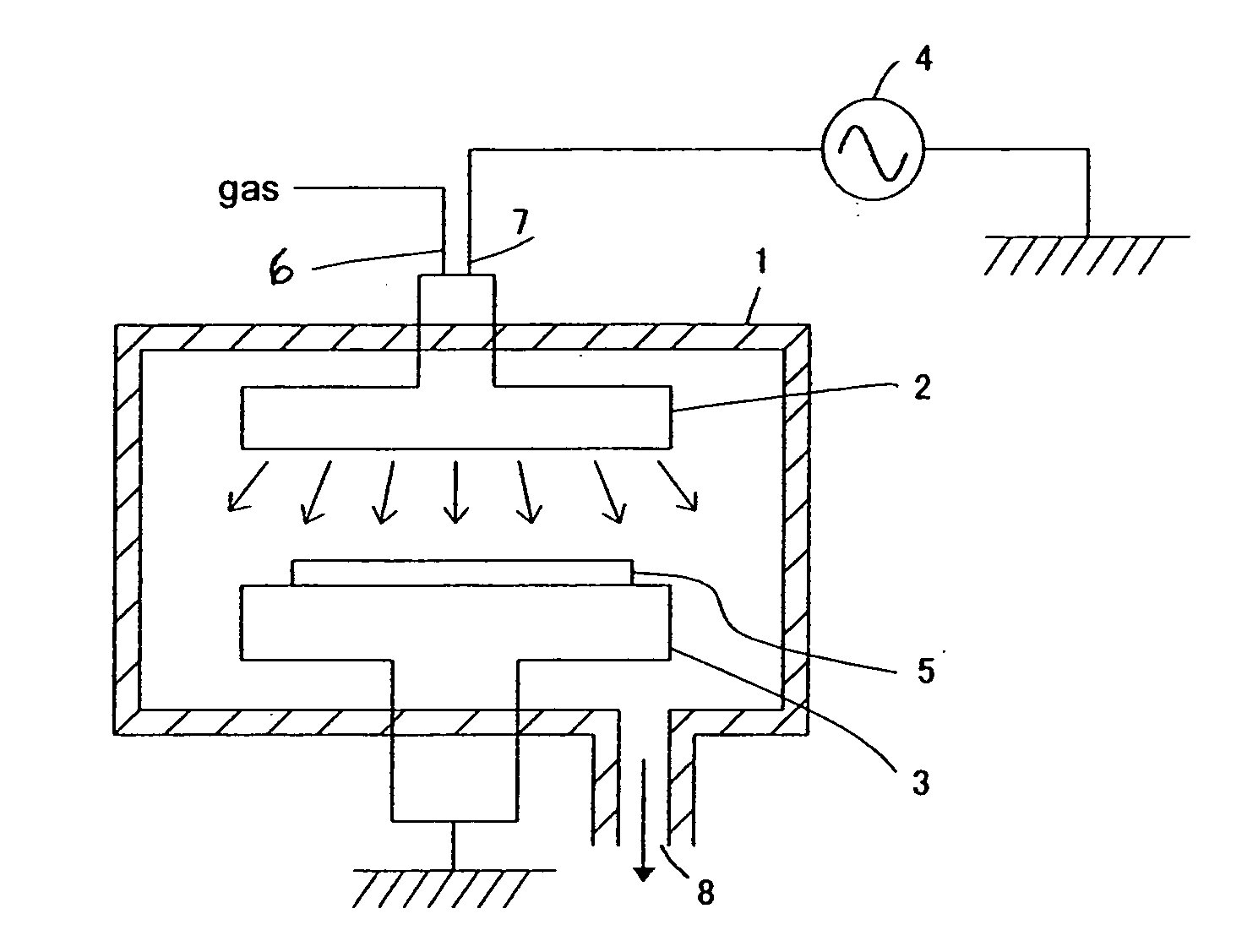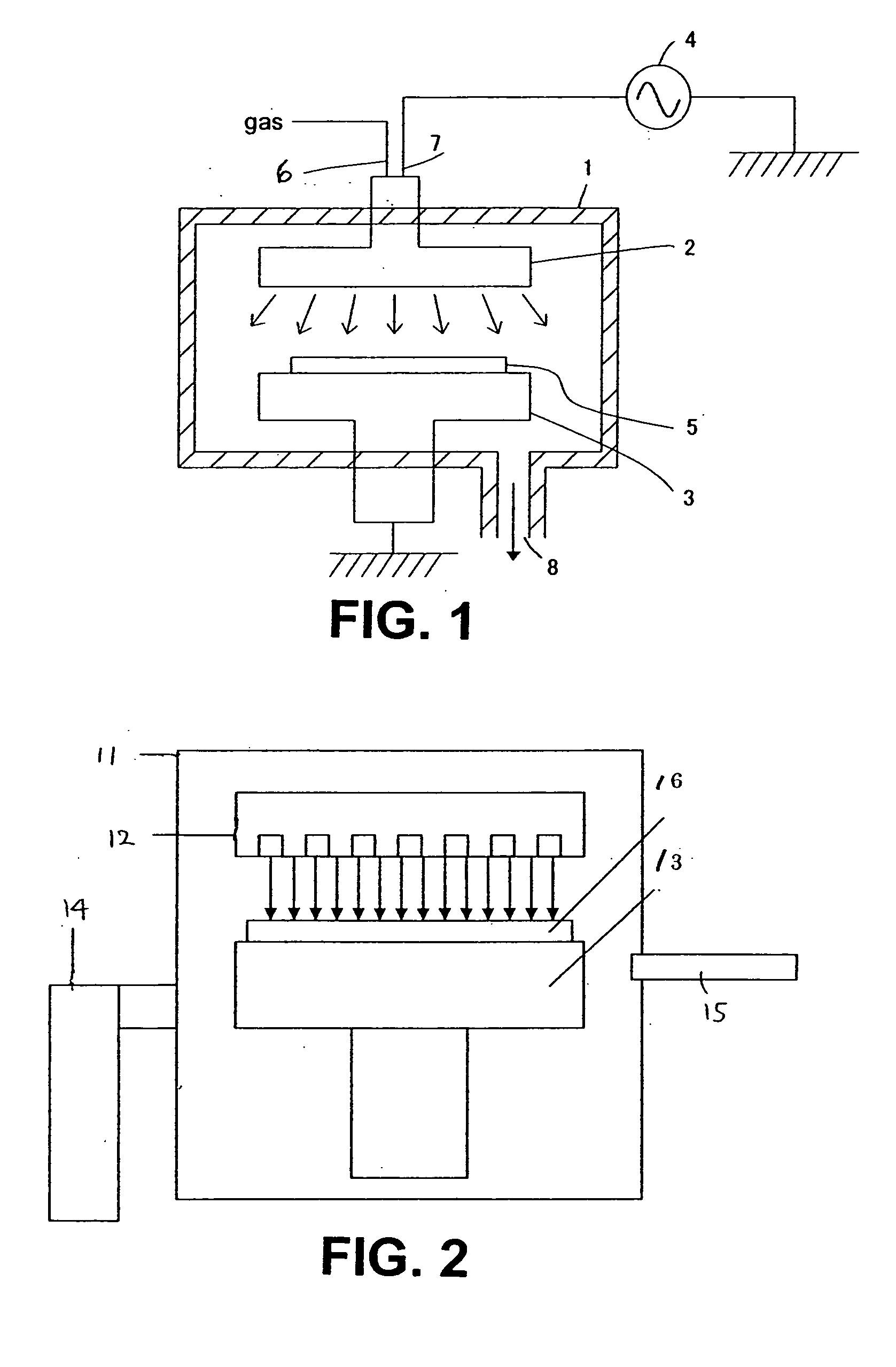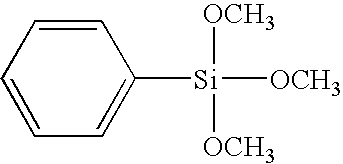Method for forming insulation film
- Summary
- Abstract
- Description
- Claims
- Application Information
AI Technical Summary
Benefits of technology
Problems solved by technology
Method used
Image
Examples
example 2
[0126] An insulation film was formed on a substrate using a plasma CVD apparatus shown in FIG. 1 under the following conditions, and the resultant thin film had the following properties:
[0127] Susceptor temperature: 10° C. [0128] DM-DEOS (dimethyldiethoxysilane) flow rate: 10 sccm [0129] He flow rate: 650 sccm [0130] O2 flow rate: 500 sccm [0131] Isopropyl alcohol flow rate: 150 sccm [0132] 27 MHz RF applied: 250 W [0133] Reactor pressure: 666 Pa [0134] Space between the silicon substrate and the upper electrode: 0.024 m [0135] Residence time: 118 msec.
[0136] The thin film formed on the substrate was then annealed under the following conditions, and the annealed film had the following properties: [0137] Annealing process: Susceptor temperature: 450° C., N2: 3 SLM, Pressure: 800 Pa, Time: 600 sec. [0138] Dielectric constant: 2.7 [0139] Film shrinkage: 10.3% [0140] Modulus: 6 GPa [0141] Film stress: 55 MPa (tensile) [0142] Filling property (Padding property): Voids were not observed...
example 3
[0143] An insulation film was formed on a substrate using a plasma CVD apparatus shown in FIG. 1 under the following conditions, and the resultant thin film had the following properties: [0144] Susceptor temperature: 10° C. [0145] DM-DEOS (dimethyldiethoxysilane) flow rate: 10 sccm [0146] He flow rate: 700 sccm [0147] O2 flow rate: 200 sccm [0148] Isopropyl alcohol flow rate: 150 sccm [0149] 27 MHz RF applied: 250 W [0150] Reactor pressure: 666 Pa [0151] Space between the silicon substrate and the upper electrode: 0.024 m [0152] Residence time: 113 msec.
[0153] The thin film formed on the substrate was then annealed under the following conditions, and the annealed film had the following properties: [0154] Annealing process: Susceptor temperature: 400° C., N2: 3 SLM, Pressure: 800 Pa, Time: 600 sec. [0155] Dielectric constant: 2.6 [0156] Film shrinkage: 12.3% [0157] Modulus: 8 GPa [0158] Film stress: 60 MPa (tensile) [0159] Filling property (Padding property): Voids were not observed...
example 4
[0160] An insulation film was formed on a substrate using a plasma CVD apparatus shown in FIG. 1 under the following conditions, and the resultant thin film had the following properties: [0161] Susceptor temperature: 0° C. [0162] TEOS (triethoxysilane) flow rate: 10 sccm [0163] He flow rate: 650 sccm [0164] O2 flow rate: 0 sccm [0165] Isopropyl alcohol flow rate: 150 sccm [0166] 27 MHz RF applied: 250 W [0167] Reactor pressure: 666 Pa [0168] Space between the silicon substrate and the upper electrode: 0.020 m [0169] Residence time: 153 msec.
[0170] The thin film formed on the substrate was then annealed under the following conditions, and the annealed film had the following properties: [0171] Annealing process: Susceptor temperature: 700° C., N2: 3 SLM, Pressure: 800 Pa, Time: 600 sec. [0172] Dielectric constant: 3.9 [0173] Film shrinkage: 30% [0174] Film stress: 0 MPa (tensile) [0175] Filling property (Padding property): The film (oxide film) was able to be deposited selectively in...
PUM
| Property | Measurement | Unit |
|---|---|---|
| Temperature | aaaaa | aaaaa |
| Temperature | aaaaa | aaaaa |
| Temperature | aaaaa | aaaaa |
Abstract
Description
Claims
Application Information
 Login to View More
Login to View More - R&D
- Intellectual Property
- Life Sciences
- Materials
- Tech Scout
- Unparalleled Data Quality
- Higher Quality Content
- 60% Fewer Hallucinations
Browse by: Latest US Patents, China's latest patents, Technical Efficacy Thesaurus, Application Domain, Technology Topic, Popular Technical Reports.
© 2025 PatSnap. All rights reserved.Legal|Privacy policy|Modern Slavery Act Transparency Statement|Sitemap|About US| Contact US: help@patsnap.com



